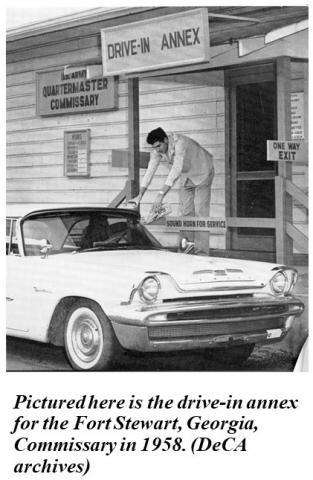BEFORE COMMISSARY CLICK2GO … Today’s curbside pickup program had its roots in military commissaries with branch stores that functioned as drive-in outlets

NOTE: To see a video related to the history of annex stores and drive-thrus, click here.
FORT LEE, Va. – Once upon a time, a number of commissaries had small branch stores that allowed customers to conveniently phone in their orders, drive up to that facility and pick up their groceries.
It wasn’t quite Commissary CLICK2GO, but it was a precursor of things to come.
“When you look back into the history of military commissaries it’s amazing to see the roots of services like the curbside pickup we’re offering today,” said Marine Sgt. Maj. Michael R. Saucedo, senior enlisted advisor to the Defense Commissary Agency director. “It’s a testament to the fact that a good idea doesn’t have a shelf life.”
So, what’s the story about commissaries and their drive-up branch stores?
The number of commissaries grew during and after World War II, but not nearly fast enough to keep up with the number of military bases or the military family population. Throughout the 1950s and 1960s, most commissaries still remained low on the priority list for funds for renovations and new facility construction.
This funding shortage forced most bases to “make do” with whatever facilities they already had. One common solution was to create a store annex or a branch store. These smaller operations allowed customers to quickly run in and pick up a few items such as bread, milk and paper towels.
The Troop Support Agency, the organization that managed Army commissaries, called these stores “Mini Coms” and the Air Force Commissary Service dubbed theirs “Wee Serve,” which reflected on their motto “We Serve Where You Serve.”
Sometimes these annexes were established as separate “neighborhood stores.” In some instances, the branch operations were separate areas within the main store building, but were walled off from the rest of the store. They kept different hours than the main store and were accessed by separate entrances.
Several of these branch stores allowed customers to call in their order over the phone, select a time to pick their groceries up and have them brought out to their car when they arrived. Although most annexes and branches were walk-in stores, a few had a window service that turned them into “drive-ins” – also known as “drive-throughs” or “drive-thrus.”
Most of the branch stores with drive-up service were open longer hours to serve customers later in the evening or early in the morning before the regular commissary opened.
The drive-in made possible incredibly quick shopping trips, during which the customer never left the vehicle. A customer could purchase a half-dozen items and be on his or her way in a matter of minutes. Such was the case at Port Hueneme, California, in 1961. The drive-in annex was attached to the main store, but it reduced congestion in the main store and in the parking lot by enabling customers to shop without getting out of their cars.
Some stores used the drive-in concept exclusively for parcel pick-up. This was especially popular at locations where there were not enough baggers to carry every customer’s purchases to their cars. Customers would walk through the store as usual, selecting items, but at the register their groceries would be tagged with a number, and when the customer drove up to the pick-up window, he would present a matching claim ticket to the attendant. Some stores, such as the main store at Fort Leavenworth, Kansas, in 1965, provided a roof or a partial overhang for the parcel pick-up area.
Yesterday’s branch store call-in and pickup operations have evolved into today’s Commissary CLICK2GO.
“Our online ordering-curbside pick program makes shopping fun with features offering helpful product details, a robust selection of recipes, featured sales and promotions and now you can even pay online,” Saucedo said. “You arrive at your commissary and we’ll get your groceries loaded and off you go. It’s as easy as that.”
DeCA’s evolution of convenience continues with its testing of a delivery service at eight stateside installations that began June 1 and ends Aug. 30. The service allows patrons within a 20-mile radius of the participating commissary to order groceries online via Commissary CLICK2GO, and have them delivered to their front door. The test period is one of the tools the agency is using to determine future expansion of Commissary CLICK2GO delivery.
-DeCA-
NOTE: Portions of this article came from "The Illustrated History of American Military Commissaries" by Dr. Peter Skirbunt, former DeCA historian
About DeCA: The Defense Commissary Agency operates a worldwide chain of commissaries providing groceries to military personnel, retirees and their families in a safe and secure shopping environment. Commissaries provide a military benefit, saving authorized patrons thousands of dollars annually on their purchases compared to similar products at commercial retailers. The discounted prices include a 5-percent surcharge, which covers the costs of building new commissaries and modernizing existing ones. A core military family support element, and a valued part of military pay and benefits, commissaries contribute to family readiness, enhance the quality of life for America’s military and their families, and help recruit and retain the best and brightest men and women to serve their country.
